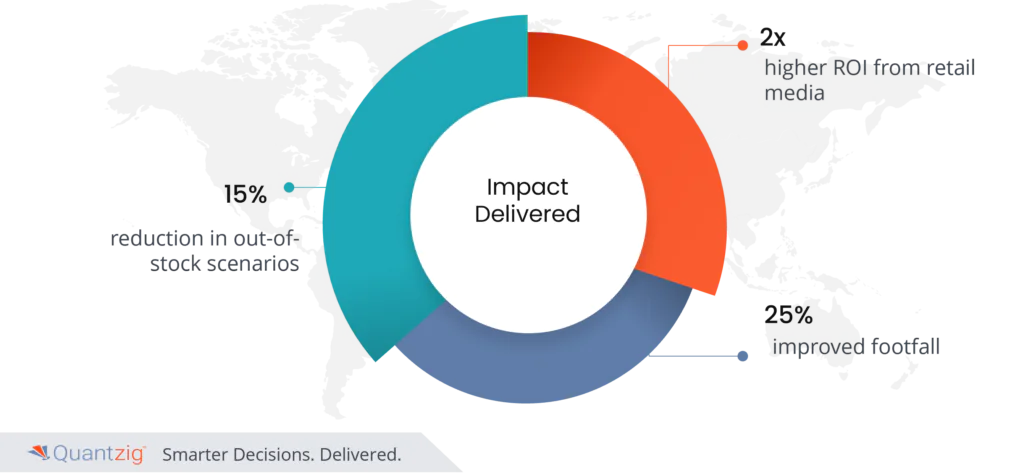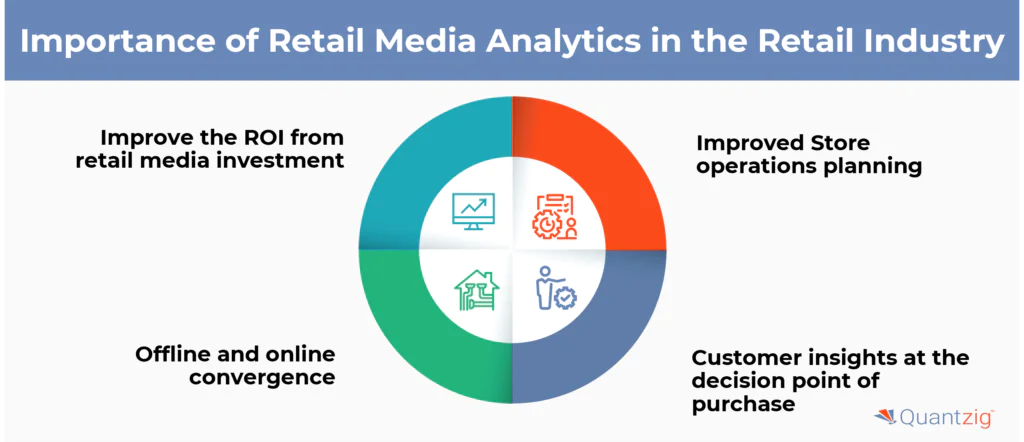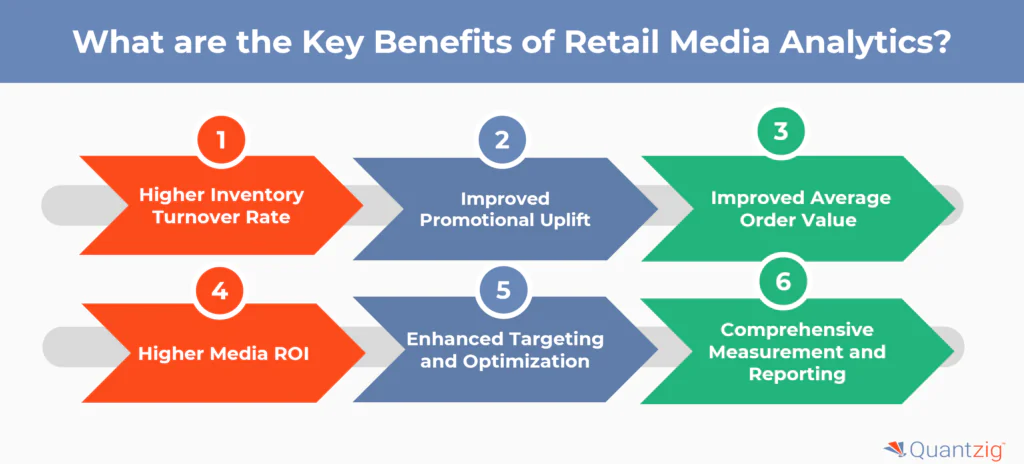Author: Associate Vice President, Analytics and Data Strategy, Quantzig.
Table of Contents
Introduction to Retail Media Analytics
In the retail sector, the convergence of commerce and digital advertising has spawned a potent and transformative force termed Retail Media. As businesses navigate the shifting landscape of consumer behavior and e-commerce, the strategic deployment of Retail Media Analytics emerges as a pivotal instrument for success.
In an age where consumers are bombarded with information and choices, retailers are exploring inventive methods to captivate and interact with their audience. Retail Media, an amalgamation of e-commerce and advertising, has emerged as an enticing solution. It facilitates brands in seamlessly embedding their advertising campaigns within the retail media network, augmenting visibility, relevance, and conversion rates. This article explores how Retail Media Analytics is revolutionizing the retail landscape, propelling businesses towards enhanced efficiency, relevance, and customer-centricity.
Book a demo to experience the meaningful insights we derive from data through our retail media analytical tools and platform capabilities. Schedule a demo today!
Request a Free DemoWhat is Retail Media?

Retail media are the networks and platforms for advertising run by retailers that let brands directly advertise products on their websites, apps, and digital displays found inside their stores. By delivering targeted advertisements based on retailer customer data, this strategy improves marketing effectiveness and return on investment. Retail media has grown to be a substantial source of income for merchants as well as an efficient way for brands to connect with customers at the point of sale.
Quantzig’s Expertise in Retail Media Analytics Solution for a Leading E-commerce Retailer
| Category | Details |
|---|---|
| Client Details | A leading e-commerce retailer located in the United States. |
| Challenges Faced by The Client | High stock on hand but low availability of products in store, revenue leaks because of out-of-stock, and low media return on investment. |
| Solutions Offered by Quantzig | Quantzig developed laddered stage media attribution models, store compliance analytics solutions, and demand planning solutions for instore execution planning. |
| Impact Delivered | Achieved a 15% reduction in out-of-stock scenarios through optimized Inventory Management. Experienced a 2x higher ROI from retail media with targeted Bids and Budgets. Witnessed a 25% improvement in footfall by leveraging Omnichannel Attribution. |
Client Details:
A leading e-commerce retailer located in the United States
Client Challenges:
1. High stock on hand but low availability of products in store
The Retail client grappled with the complex task of maintaining an appropriate balance between the stock in their warehouses and ensuring that products are readily available to customers in physical stores. Several factors contributed to this challenge, including inaccurate demand forecasting, supply chain disruptions, and inefficient inventory management systems. Consequently, a surplus of stock in the warehouse coexisted with empty store shelves, resulting in suboptimal customer experiences, missed sales opportunities and elevated carrying costs.
2. Revenue leaks because of out-of-stock
The retailer was facing the detrimental consequences of out-of-stock situations. When customers visit a store or browse online and find that the desired products are unavailable, it leads to immediate revenue loss. Beyond the financial impact, this can also damage brand reputation and erode customer loyalty. Out-of-stock incidents occurred due to inventory inaccuracies, inefficient restocking processes, and insufficient demand forecasting.
3. Low media return on investment
In the increasingly competitive retail landscape, the client allocated substantial budgets to digital retail marketing and advertising campaigns across various platforms. However, achieving a favorable return on investment (ROI) on these expenditures proved elusive. Factors such as ineffective targeting, an inability to accurately measure campaign performance and the lack of a clear connection between marketing efforts and sales outcomes resulted in a subpar media ROI.
These challenges underscored the need for the client to adopt advanced technologies, streamline supply chain operations, and embrace data-driven decision-making processes. Addressing these issues not only enhances profitability but also elevates the overall customer experience, fostering brand loyalty and long-term success in the ever-evolving retail industry.
Retail Media Analytics Solutions Offered by Quantzig:
1. Laddered stage media attribution models
Quantzig implemented laddered stage media attribution models for the retail client, providing a comprehensive view of the impact of their media campaigns across multiple touchpoints. These models enabled the client to track customer interactions with their brand at various stages of the buying journey. By assigning appropriate attribution to each touchpoint, they gained insights into the effectiveness of different media channels and campaign elements. This data-driven approach empowered the retail company to optimize their marketing strategies, allocate budgets more efficiently, and achieve a higher return on investment (ROI) for their media spending.
2. Unified media impact and demand planning solutions for instore execution planning
We developed unified media impact and demand planning solutions that integrated data from online and offline channels. This allowed the retail client to align their in-store execution planning with the impact of their media campaigns. By synchronizing online retail advertising efforts with in-store promotions and inventory management, they improved product availability, reduced out-of-stock incidents, and enhanced the overall customer experience. This holistic approach to planning helped the company maximize sales opportunities and minimize revenue leaks.
3. Store compliance analytics solutions
Our store compliance analytics solutions provided the retail client with real-time insights into store-level operations and compliance with corporate standards. By monitoring key performance indicators and compliance metrics, they could identify areas requiring improvement. This proactive approach allowed the client to maintain consistency in brand presentation, optimize store layouts, and enhance consumer engagement. As a result, they achieved higher customer satisfaction and increased sales, while also improving operational efficiency and reducing compliance-related issues.
To encapsulate, Quantzig’s data-driven solutions provided the retail client with the tools to make informed decisions, optimize their Ad Strategies, and enhance in-store execution planning and compliance. These enhancements led to tangible benefits, including increased Sales, improved ROI Insights, and a fortified competitive stance within the retail industry.
Impact Delivered from Quantzig’s Retail Media Analytics Solution:

- Achieved a 15% reduction in out-of-stock scenarios through optimized Inventory Management.
- Experienced a 2x higher ROI from retail media with targeted Bids and Budgets.
- Witnessed a 25% improvement in footfall by leveraging Omnichannel Attribution.
Get started with your complimentary trial today and delve into our platform without any obligations. Explore our wide range of customized, consumption driven analytical solutions services built across the analytical maturity levels.
Start your Free TrialImportance of Retail Media Analytics in the Retail Industry

The Importance of Retail Media Analytics stands as a beacon of strategic relevance amid the ever-evolving dynamics of consumer behavior and e-commerce. As the retail sector navigates through a realm inundated with information and choices, the synergy between Retail Media and Advertising Strategies emerges as a pivotal axis for businesses seeking to capture and engage their audience effectively. In this era defined by data-driven decision-making, Retail Media Analytics Platforms wield unprecedented power, offering Actionable Insights gleaned from Audience Analytics and Consumer Behavior metrics. This introduction sets the stage for a comprehensive exploration of how Retail Media Analytics reshapes the retail industry, driving efficiency, relevance, and customer-centricity through the strategic utilization of data-driven methodologies and Predictive Analytics.
1. Improve the ROI from retail media investment:
In the fiercely competitive retail industry, optimizing Return on Investment (ROI) from retail media investment is paramount. This is where Retail Media Analytics steps in as a game-changer. It empowers retailers to dissect customer data with precision and unveil crucial insights into shopping behaviors, preferences, and trends. By leveraging these insights, businesses can curate highly targeted and personalized advertising campaigns, and ensure that every advertising dollar is maximized for impact. Moreover, Retail Media Analytics facilitates the assessment of campaign performance in real time, enabling swift adjustments to strategies, cost-efficiency improvements, and enhanced customer engagement.
2. Improved Store operations planning:
First and foremost, Retail Media Analytics offers invaluable customer behavior insights. It enables retailers to understand shopper preferences, purchase patterns, and even the influence of advertising on in-store decisions. Armed with this knowledge, retailers can tailor their inventory management, staffing levels, and store layouts to better align with customer demands, reducing waste and boosting sales.
Retail Media Analytics represents the bridge between online and offline retail, allowing retailers to seamlessly integrate their digital advertising efforts with in-store operations. By optimizing store operations through data-driven decision-making, retailers can create more engaging and satisfying personalized experiences, which, in turn, drive higher customer loyalty and revenue. It’s a potent tool in the arsenal of modern retailers seeking sustainable growth and competitiveness.
3. Offline and online convergence:
The convergence of offline and online retail media advertising represents a pivotal juncture in the evolution of the retail industry, and Retail Media Analytics plays a pivotal role in this transformation. As consumers seamlessly transition between physical stores and digital platforms, retailers must adapt and optimize their strategies to thrive in this dynamic landscape.
This tool plays a paramount role by providing a unified view of customer behavior across both offline and online channels. It enables retailers to track customer journeys, preferences, and purchase patterns holistically, breaking down the barriers between these two domains. This holistic understanding empowers businesses to craft highly personalized and consistent shopping experiences, regardless of the channel. In an era where the lines between offline and online retail continue to blur, Retail Media Analytics is indispensable for retailers looking to thrive in this new landscape.
4. Customer insights at the decision point of purchase:
Customer insights at the decision point of purchase are the Holy Grail for retailers, and Retail Media Analytics serves as the key to unlocking this treasure trove of knowledge. In the critical moments when customers are poised to make buying decisions, this tool provides real-time, data-driven insights that can make all the difference. By harnessing this technology, retailers gain a deep understanding of customer behavior and preferences right at the point of purchase. This empowers them to deliver personalized offers, product recommendations, and promotions that resonate with individual shoppers, increasing the likelihood of conversion and upselling.
Experience the advantages firsthand by testing a customized complimentary pilot designed to address your specific retail media analytics requirements. Pilot studies are non-committal in nature.
Request a Free PilotWhat are the Key Benefits of Retail Media Analytics?
The Key Benefits of Retail Media Analytics emerge as crucial components in navigating the complex landscape of consumer behavior, advertising strategies, and revenue optimization. By harnessing the power of Real-Time Analytics, Predictive Analytics, and Machine Learning within Retail Media Analytics Platforms, retailers can unlock actionable insights that drive informed decision-making. From optimizing Click-through-rate (CTR) and Cost-per-click (CPC) metrics to capitalizing on emerging Retail Media Trends and Advertising Opportunities, this section delves into how Retail Media Analytics serves as a cornerstone for enhancing customer experiences, boosting sales, and fostering lasting Brand Loyalty in today’s competitive marketplace.

1. Higher Inventory Turnover Rate:
This tool revolutionizes inventory management by offering precise insights into consumer behavior and demand patterns. Retailers can optimize stock levels, ensuring that popular products are always available while minimizing excess inventory. This not only reduces carrying costs but also minimizes the risk of stockouts, which can lead to lost sales and dissatisfied customers. By aligning inventory with consumer preferences, retailers can achieve a higher inventory turnover rate, enhance cash flow and profitability, and maintain a responsive supply chain.
2. Improved Promotional Uplift:
Retailers invest significant resources in promotions to attract and retain customers. Retail Media Analytics enables them to analyze the effectiveness of these promotions in real time. By leveraging data visualizations, probabilistic models, and real-time analytics powered by machine learning, retailers can identify what resonates with consumers and what doesn’t within the global retail media advertising market. This enables them to fine-tune their promotional strategies, optimizing KPIs and maximizing revenue streams.
As marketing efforts become more precise and data-driven, retailers can better capitalize on advertising opportunities and retail media trends, leading to higher conversion rates and increased sales during promotional periods. By understanding consumer behavior and the impact of retail media ads, retailers can further refine their promotional approaches, ensuring greater effectiveness and return on investment.
3. Improved Average Order Value:
Retail Media Analytics, powered by statistics, datasets and recommendations, empowers retailers to influence customer behavior by tailoring product recommendations and incentives. By leveraging first-party data and insights from datasets, retailers can understand individual shopper preferences and purchase history, enabling them to strategically upsell and cross-sell. This personalized and data-driven approach, supported by reporting templates and alerts and notifications, contributes to an improved average order value and increased revenue across online and offline sales channels. Moreover, with features such as fraud detection and compliance with regulations, retailers can ensure the integrity of their operations, especially in the consumer-packaged goods (CPG) sector.
4. Higher Media ROI:
With Retail Media Analytics, retailers can track and evaluate the performance of their advertising campaigns in real time. This granular insight into the effectiveness of various media channels, content, and placements allows for informed decision-making. Retailers can allocate their media budgets more efficiently and focus on strategies that deliver the highest return on investment. This optimization leads to a higher media ROI, ensuring that every advertising dollar spent generates the maximum impact, whether it’s in-store, online, or across various channels.
5. Enhanced Targeting and Optimization:
Retail media analytics empowers businesses with precise targeting and optimization of their product listings and retail media tactics. By utilizing comprehensive purchase data and audience analytics, companies gain actionable insights that enhance their advertising strategies across both online touchpoints and offline touchpoints. This data-driven approach supports an effective omnichannel planning approach, ensuring that marketing efforts are aligned with consumer behavior. The result is a maximized return on ad spend (ROAS), as campaigns are more accurately directed towards the most receptive audiences, improving overall efficiency and impact.
6. Comprehensive Measurement and Reporting:
With robust campaign reporting and retail media measurement, businesses benefit from comprehensive multitouch attribution. This level of analysis allows marketers to understand the full impact of their retail media networks and retail media tactics on consumer behavior. Enhanced retargeting strategies are developed from these insights, improving both engagement and conversion rates. By analyzing data across all online touchpoints and offline touchpoints, companies can refine their strategies to increase market share and drive better outcomes, ensuring that every marketing dollar is effectively spent.
In essence, this tool serves as a catalyst for retailers to revolutionize their operations and Advertising Strategies. By leveraging insights from Audience Analytics, Predictive Analytics, and Real-Time Analytics, retailers can streamline inventory management, optimize promotions, boost order values, and amplify the ROI of their advertising investments. This holistic approach not only drives profitability but also fortifies retailers to excel in the cutthroat Global Retail Media Advertising Market.
Conclusion:
As retailers strive to navigate the dynamic landscape of offline and online convergence, optimize inventory turnover, and enhance customer experiences, Retail Media Analytics emerges as the indispensable tool that empowers them to thrive. By leveraging the power of data and analytics, retailers can not only survive but also flourish in an era defined by data-driven decisions, personalization, and customer-centricity.
The future of retail belongs to those who harness the capabilities of Retail Media Analytics and set a new standard for success in the ever-evolving world of commerce, shaping advertising strategies and marketing strategies to resonate with target audiences and consumer segments while optimizing profit margins and fostering engagement and conversion rates among shoppers through compelling offers.



